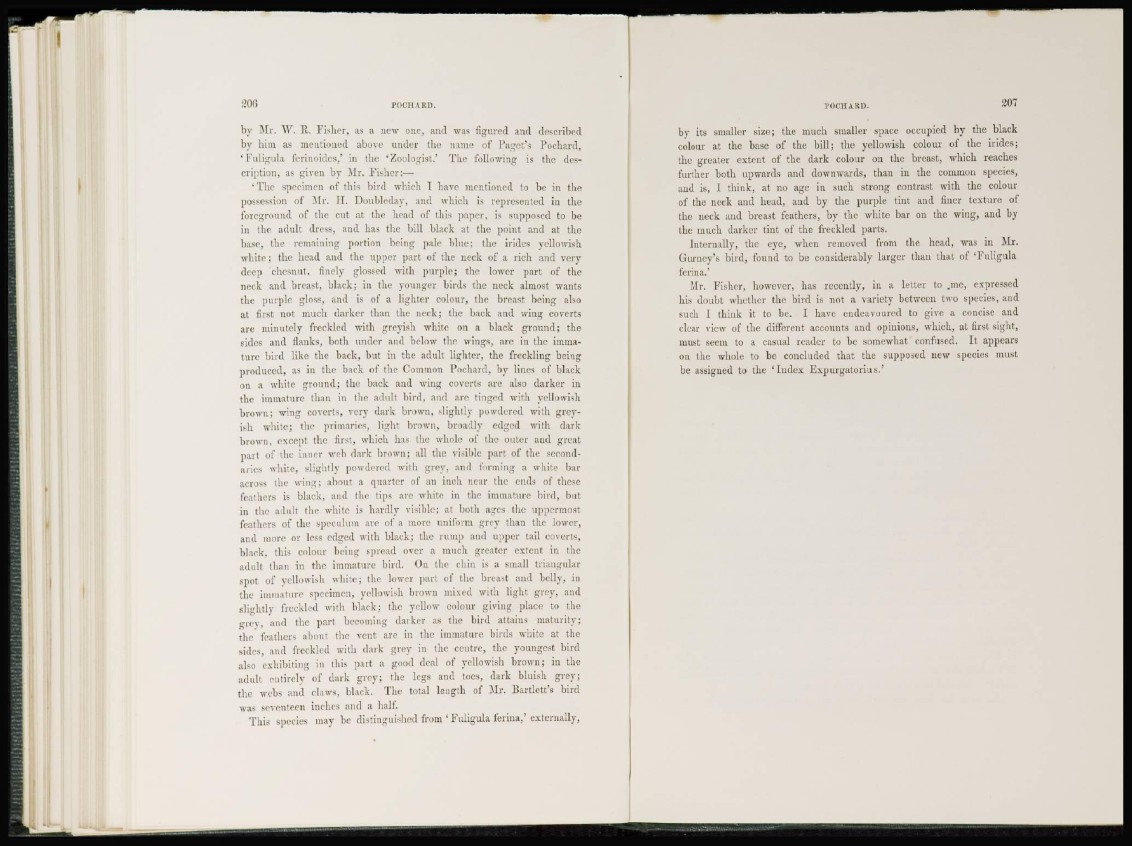
806 POCHARD.
by Mr. W. R. Fisher, as a new one, and was figured and described
by him as mentioned above under the name of Pagct's Pochard,
' F u l i g u l a feriuoides,* in the 'Zoologist.' The following is the description,
as given bv Mr. Fisher:—
' T h e specimen of this bird which I have mentioned to be in the
possesion of Mr. II. Doubleclay, and which is represented in the
foreground of the cut at the head of this paper, is supposed to be
in the adult dress, and has the bill black at the point and at the
base, the remaining portion being pale blue; the irides yellowish
white; the head and the upper part of the neck of a rich and very
deep chesnut, finely glossed with purple; the lower part of the
neck and breast, black; in the younger birds the neck almost wants
the purple gloss, and is of a lighter colour, the breast being also
at first not much darker than the neck; the back and wing coverts
are minutely freckled with greyish white on a black ground; the
sides and flanks, both under and below the wings, arc in the immat
u r e bird like the back, but in the adult lighter, the freckling being
produced, as in the back of the Common Pochard, by lines of black
on a white ground; the back and wing coverts arc also darker in
the immature than in the adult bird, and are tinged with yellowish
brown; wing coverts, very dark brown, slightly powdered with greyish
white; the primaries, light brown, broadly edged with dark
brown, except the first, which has the whole of the outer and great
part of the inner web dark brown; all the visible part of the seconda
r i e s white, slightly powdered with grey, and forming a white bar
across the wing; about a quarter of an inch near the ends of these
feathers is black, and the tips are white in the immature bird, but
in the adult the white is hardly visible; at both ages the uppermost
feathers of the speculum are of a more uniform grey than the lower,
and more or less edged witli black; the ramp and upper tail coverts,
black, this colour being spread over a much greater extent in the
adult than in the immature bird. On the chin is a small triangular
spot of yellowish white; the lower part of the breast and belly, in
the immature specimen, yellowish brown mixed with light grey, and
slightly freckled with black; the yellow colour giving place to the
grey, and the part becoming darker as the bird attains maturity;
the feathers about the vent are in the imniafure birds white at the
sides, and freckled with dark grey in the centre, the youngest bird
also exhibiting in this part a good deal of yellowish brown; in the
adult entirely of dark grey; the legs and toes, dark bluish grey;
the webs and claws, black. The total length of Mr. Bartlett's bird
was seventeen inches and a half.
This species may be distinguished from ' Fuligula ferina,' externally,
POCHARD. 207
by its smaller size; the much smaller space occupied by the black
colour at the base of the bill; the yellowish colour of the irides;
the greater extent of the dark colour on the breast, which reaches
further both upwards and downwards, than in the common species,
and is, I think, at no age in such strong contrast with the colour
of the neck and head, and by the purple tint and finer texture of
the neck and breast feathers, by the white bar on the wing, and by
the much darker tint of the freckled parts.
Internally, the eye, when removed from the head, was in Mr.
Gurucy's bird, found to be considerably larger than that of 'Fuligula
ferina.'
Mr. Fisher, however, has recently, in a letter to .me, expressed
his doubt whether the bird is not a variety between two species, and
such I think it to be. I have endeavoured to give a concise and
clear view of the different accounts and opinions, which, at first sight,
must seem to a casual reader to be somewhat confused. It appears
on the whole to be concluded that the supposed new species must
be assigned to the ' I n d e x Expurgatorius.'